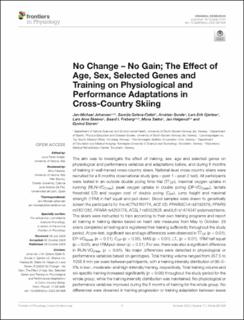| dc.contributor.author | Johansen, Jan-Michael | |
| dc.contributor.author | Goleva-Fjellet, Sannija | |
| dc.contributor.author | Sunde, Arnstein | |
| dc.contributor.author | Gjerløw, Lars Erik | |
| dc.contributor.author | Skeimo, Lars Arne Fostvedt | |
| dc.contributor.author | Freberg, Baard Ingegerdsson | |
| dc.contributor.author | Sæbø, Mona | |
| dc.contributor.author | Helgerud, Jan | |
| dc.contributor.author | Støren, Øyvind | |
| dc.date.accessioned | 2021-05-06T09:22:25Z | |
| dc.date.available | 2021-05-06T09:22:25Z | |
| dc.date.created | 2020-11-06T12:41:18Z | |
| dc.date.issued | 2020 | |
| dc.identifier.citation | Johansen, J. M., Goleva-Fjellet, S., Sunde, A., Gjerløw, L. E., Skeimo, L. A., Freberg, B. I., ... & Støren, Ø. (2020). No Change–No Gain; The Effect of Age, Sex, Selected Genes and Training on Physiological and Performance Adaptations in Cross-Country Skiing. Frontiers in physiology, 11. | en_US |
| dc.identifier.issn | 1664-042X | |
| dc.identifier.uri | https://hdl.handle.net/11250/2753879 | |
| dc.description.abstract | The aim was to investigate the effect of training, sex, age and selected genes on physiological and performance variables and adaptations before, and during 6 months of training in well-trained cross-country skiers. National-level cross-country skiers were recruited for a 6 months observational study (pre – post 1 – post 2 test). All participants were tested in an outside double poling time trial (TTDP), maximal oxygen uptake in running (RUN-VO2max), peak oxygen uptake in double poling (DP-VO2peak), lactate threshold (LT) and oxygen cost of double poling (CDP), jump height and maximal strength (1RM) in half squat and pull-down. Blood samples were drawn to genetically screen the participants for the ACTN3 R577X, ACE I/D, PPARGC1A rs8192678, PPARG rs1801282, PPARA rs4253778, ACSL1 rs6552828, and IL6 rs1474347 polymorphisms. The skiers were instructed to train according to their own training programs and report all training in training diaries based on heart rate measures from May to October. 29 skiers completed all testing and registered their training sufficiently throughout the study period. At pre-test, significant sex and age differences were observed in TTDP (p < 0.01), DP-VO2peak (p < 0.01), CDP (p < 0.05), MAS (p < 0.01), LTv (p < 0.01), 1RM half squat (p < 0.01), and 1RM pull-down (p < 0.01). For sex, there was also a significant difference in RUN-VO2max (p < 0.01). No major differences were detected in physiological or performance variables based on genotypes. Total training volume ranged from 357.5 to 1056.8 min per week between participants, with a training intensity distribution of 90–5–5% in low-, moderate- and high-intensity training, respectively. Total training volume and ski-specific training increased significantly (p < 0.05) throughout the study period for the whole group, while the training intensity distribution was maintained. No physiological or performance variables improved during the 6 months of training for the whole group. No differences were observed in training progression or training adaptation between sexes or age-groups. In conclusion, sex and age affected physiological and performance variables, with only a minor impact from selected genes, at baseline. However, minor to no effect of sex, age, selected genes or the participants training were shown on training adaptations. Increased total training volume did not affect physiological and performance variables. | en_US |
| dc.language.iso | eng | en_US |
| dc.rights | Navngivelse 4.0 Internasjonal | * |
| dc.rights.uri | http://creativecommons.org/licenses/by/4.0/deed.no | * |
| dc.title | No change – no gain; The effect of age, sex, selected genes and training on physiological and performance adaptations in cross-country skiing | en_US |
| dc.type | Peer reviewed | en_US |
| dc.type | Journal article | en_US |
| dc.description.version | publishedVersion | en_US |
| dc.rights.holder | © The Author(s) 2020. | en_US |
| dc.source.volume | 11 | en_US |
| dc.source.journal | Frontiers in Physiology | en_US |
| dc.identifier.doi | https://doi.org/10.3389/fphys.2020.581339 | |
| dc.identifier.cristin | 1845601 | |
| dc.source.articlenumber | 581339 | en_US |
| cristin.ispublished | true | |
| cristin.fulltext | original | |
| cristin.qualitycode | 1 | |

